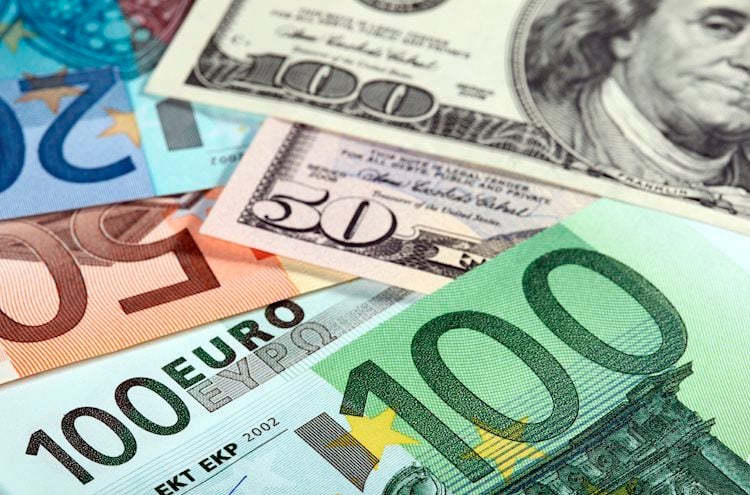Jobs
EUR/USD Forecast: Euro needs a soft US jobs report to extend rebound

- EUR/USD holds steady above 1.0700 after closing in the green on Thursday.
- April jobs data from the US could trigger the next big action ahead of the weekend.
- The pair could face stiff resistance at 1.0750-1.0755.
EUR/USD gained traction in the second half of the day on Thursday and closed in positive territory. The pair stays in a consolidation phase above 1.0700 early Friday as investors gear up for the last high-impact data release of the week, April jobs report from the US.
The positive shift seen in risk mood caused the US Dollar to come under bearish pressure in the American session on Thursday and helped EUR/USD turn north following the pullback seen in the European session.
Nonfarm Payrolls (NFP) in the US are forecast to rise 238,000 in April following the 303,000 increase recorded in March. In case NFP comes in above the market expectation, the initial reaction could trigger a USD rebound and weigh on the pair. A disappointing reading, close to 150,000, could force the USD to continue to weaken ahead of the weekend and open the door for another leg higher in the pair.
Investors will also pay close attention to revisions and the wage inflation component. Even if the headline NFP comes in better than forecast, a significant downward revision to the previous prints could still make it difficult for the USD to find demand. Average Hourly Earnings are anticipated to rise 4% on a yearly basis. In case the NFP arrives close to the market consensus, a soft wage inflation figure could hurt the USD.
EUR/USD Technical Analysis
The Relative Strength Index (RSI) indicator on the 4-hour chart stays above 50 and EUR/USD holds comfortably above the 100, 50 and 20-period Simple Moving Averages (SMA), suggesting that the bullish bias stays intact.
Immediate resistance is located at 1.0750 – 1.0755 (Fibonacci 38.2% retracement of the latest downtrend, 200-period SMA). If EUR/USD stabilizes above that region, 1.0790 – 1.0800 (Fibonacci 50% retracement, static level) and 1.0830 (Fibonacci 61.8% retracement) could be seen as next bullish targets.
On the downside, 1.0700 (Fibonacci 23.6% retracement, 50-period SMA) aligns as first before 1.0680 (100-period SMA) and 1.0650 (static level).
Euro FAQs
The Euro is the currency for the 20 European Union countries that belong to the Eurozone. It is the second most heavily traded currency in the world behind the US Dollar. In 2022, it accounted for 31% of all foreign exchange transactions, with an average daily turnover of over $2.2 trillion a day. EUR/USD is the most heavily traded currency pair in the world, accounting for an estimated 30% off all transactions, followed by EUR/JPY (4%), EUR/GBP (3%) and EUR/AUD (2%).
The European Central Bank (ECB) in Frankfurt, Germany, is the reserve bank for the Eurozone. The ECB sets interest rates and manages monetary policy. The ECB’s primary mandate is to maintain price stability, which means either controlling inflation or stimulating growth. Its primary tool is the raising or lowering of interest rates. Relatively high interest rates – or the expectation of higher rates – will usually benefit the Euro and vice versa. The ECB Governing Council makes monetary policy decisions at meetings held eight times a year. Decisions are made by heads of the Eurozone national banks and six permanent members, including the President of the ECB, Christine Lagarde.
Eurozone inflation data, measured by the Harmonized Index of Consumer Prices (HICP), is an important econometric for the Euro. If inflation rises more than expected, especially if above the ECB’s 2% target, it obliges the ECB to raise interest rates to bring it back under control. Relatively high interest rates compared to its counterparts will usually benefit the Euro, as it makes the region more attractive as a place for global investors to park their money.
Data releases gauge the health of the economy and can impact on the Euro. Indicators such as GDP, Manufacturing and Services PMIs, employment, and consumer sentiment surveys can all influence the direction of the single currency. A strong economy is good for the Euro. Not only does it attract more foreign investment but it may encourage the ECB to put up interest rates, which will directly strengthen the Euro. Otherwise, if economic data is weak, the Euro is likely to fall. Economic data for the four largest economies in the euro area (Germany, France, Italy and Spain) are especially significant, as they account for 75% of the Eurozone’s economy.
Another significant data release for the Euro is the Trade Balance. This indicator measures the difference between what a country earns from its exports and what it spends on imports over a given period. If a country produces highly sought after exports then its currency will gain in value purely from the extra demand created from foreign buyers seeking to purchase these goods. Therefore, a positive net Trade Balance strengthens a currency and vice versa for a negative balance.
Economic Indicator
Nonfarm Payrolls
The Nonfarm Payrolls release presents the number of new jobs created in the US during the previous month in all non-agricultural businesses; it is released by the US Bureau of Labor Statistics (BLS). The monthly changes in payrolls can be extremely volatile. The number is also subject to strong reviews, which can also trigger volatility in the Forex board. Generally speaking, a high reading is seen as bullish for the US Dollar (USD), while a low reading is seen as bearish, although previous months’ reviews and the Unemployment Rate are as relevant as the headline figure. The market’s reaction, therefore, depends on how the market assesses all the data contained in the BLS report as a whole.









